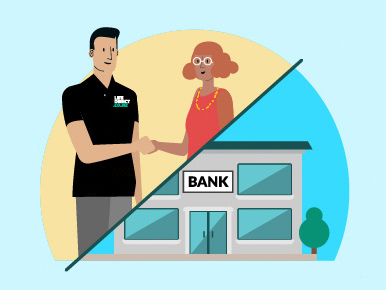For the majority of people, buying a house means taking out a mortgage.
Mortgage rates are frequently discussed in the media, and mortgage advisers around the country (such as the team at LifeDirect Mortgages!) help borrowers find a suitable mortgage fit every day.
But what is a mortgage, anyway?
The word “mortgage” comes from the old French words “mort” meaning death and “gage”, meaning pledge.
The good news is, there are no death pledges involved when you sign up for a modern mortgage.
A mortgage is the agreement that you sign with your bank or other lender that gives it the right to take your property from you and sell it if you do not meet your repayment commitments.
With that agreement in place, it lends you the money you need to buy the house, so you don’t have to save the full purchase price.
The lender then charges interest on that amount each year until the loan is paid off.
Usually, the mortgage will be structured over 20, 25 or 30 years and repayments will be set at fortnightly or monthly intervals.
You will usually have the choice of a fixed or floating interest rate.
When you have a fixed rate, that applies for a set term, such as six months, or a year or two. At the end of that time, you’ll get the chance to either refix for a new rate and term, or choose to have a variable rate loan.
When you pay your loan off, you can engage a solicitor to “discharge” the mortgage – meaning the lender no longer has any rights over your house.
While the mortgage is technically the agreement that relates to the security that the lender holds, we often talk about “mortgages” and “home loans” interchangeably.
They’re not all the same…
Most mortgages in New Zealand these days are “table” loans, which means your payments don’t change over the course of your loan (except when interest rates move).
At the beginning, most of your payment goes towards interest, and a small amount is applied to reducing the principal. As you go along, more of your payment is principal and there is less interest charged.
There are other structures available. Some people have part of their home loan lending on a revolving credit, which is a bit like a big overdraft. Other people opt for an offset facility, which uses money in a savings account to offset the interest being charged on the mortgage lending.
Many people split their lending into several parts, which can give them flexibility to fix for different terms. As your advisers, the team at LifeDirect Mortgages can help you determine what might work for you.
Ready to talk?
If you’re thinking about your mortgage needs, drop us a line. We are home loan experts and can help you through each stage of the process, to find home lending that gets you closer to your goals, more quickly.
Disclaimer: Please note that the content provided in this article is intended as an overview and as general information only. While care is taken to ensure accuracy and reliability, the information provided is subject to continuous change and may not reflect current developments or address your situation. Before making any decisions based on the information provided in this article, please use your discretion and seek independent guidance.










